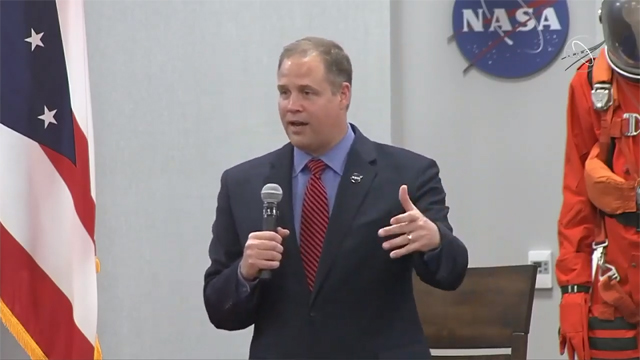NASA Chief Says US Still Aimed at a Moon Return by 2024, Despite Trump Tweet
Mars has been the goal along, he said.

As NASA is scrambling to land astronauts on the moon by 2024, the agency chief reminded employees today (June 10) that Mars — not the moon — is the agency's ultimate destination.
"The moon is not the destination. The moon is the waypoint" for an eventual human mission to Mars, NASA Administrator Jim Bridenstine said during a town hall-style discussion at NASA's Glenn Research Center in Cleveland, Ohio.
Bridenstine also defended a controversial statement from President Donald Trump, who tweeted on Friday (June 7), "NASA should NOT be talking about going to the Moon — We did that 50 years ago. They should be focused on the much bigger things we are doing, including Mars (of which the Moon is a part)."
Related: Will NASA's Rush to the Moon Get Us to Mars Any Faster?
While some suggested that Trump was throwing cold water on NASA's new moon plans (a program that the president initiated himself), reversing his own space policy and possibly confusing Earth's moon with the moons of Mars, Bridenstine offered a more forgiving interpretation of Trump's tweet.
Referring to Trump's claim that the moon is a part of Mars, Bridenstine said, "we're going to the moon in order to get to Mars." Anyone who interpreted that tweet literally is simply reading too far into it, he added.
Bridenstine speculated that Trump's tweet was prompted by a television segment on the Fox Business channel during which a discussion of NASA's plans to land astronauts on the moon in 2024 escalated into a debate over whether human exploration of the moon is even valuable. "The moon is valuable because it's a proving ground to get to Mars and that's exactly the case that the president made," Bridenstine said.
Get the Space.com Newsletter
Breaking space news, the latest updates on rocket launches, skywatching events and more!
"We need to learn how to live and work on another world," he said, adding that exploration of the moon will give NASA a chance to demonstrate the technologies that will be needed to put humans on Mars.
NASA's Lunar Orbital Platform-Gateway, a proposed lunar space station that will serve as a waypoint between Earth and the lunar surface, is one of those technologies. "It's our access to Mars," he said. "Now is the first Gateway gonna get us to Mars? No. But we need to prove the technology."
- NASA Awards $45.5 Million for Private Moon Lander Work on Project Artemis
- White House Reiterates Human Moon Missions on the Path to Mars
- How Space Station and Moon Missions Will Prep Astronauts for Mars
Email Hanneke Weitering at hweitering@space.com or follow her @hannekescience. Follow us on Twitter @Spacedotcom and on Facebook.
Join our Space Forums to keep talking space on the latest missions, night sky and more! And if you have a news tip, correction or comment, let us know at: community@space.com.

Hanneke Weitering is a multimedia journalist in the Pacific Northwest reporting on the future of aviation at FutureFlight.aero and Aviation International News and was previously the Editor for Spaceflight and Astronomy news here at Space.com. As an editor with over 10 years of experience in science journalism she has previously written for Scholastic Classroom Magazines, MedPage Today and The Joint Institute for Computational Sciences at Oak Ridge National Laboratory. After studying physics at the University of Tennessee in her hometown of Knoxville, she earned her graduate degree in Science, Health and Environmental Reporting (SHERP) from New York University. Hanneke joined the Space.com team in 2016 as a staff writer and producer, covering topics including spaceflight and astronomy. She currently lives in Seattle, home of the Space Needle, with her cat and two snakes. In her spare time, Hanneke enjoys exploring the Rocky Mountains, basking in nature and looking for dark skies to gaze at the cosmos.









